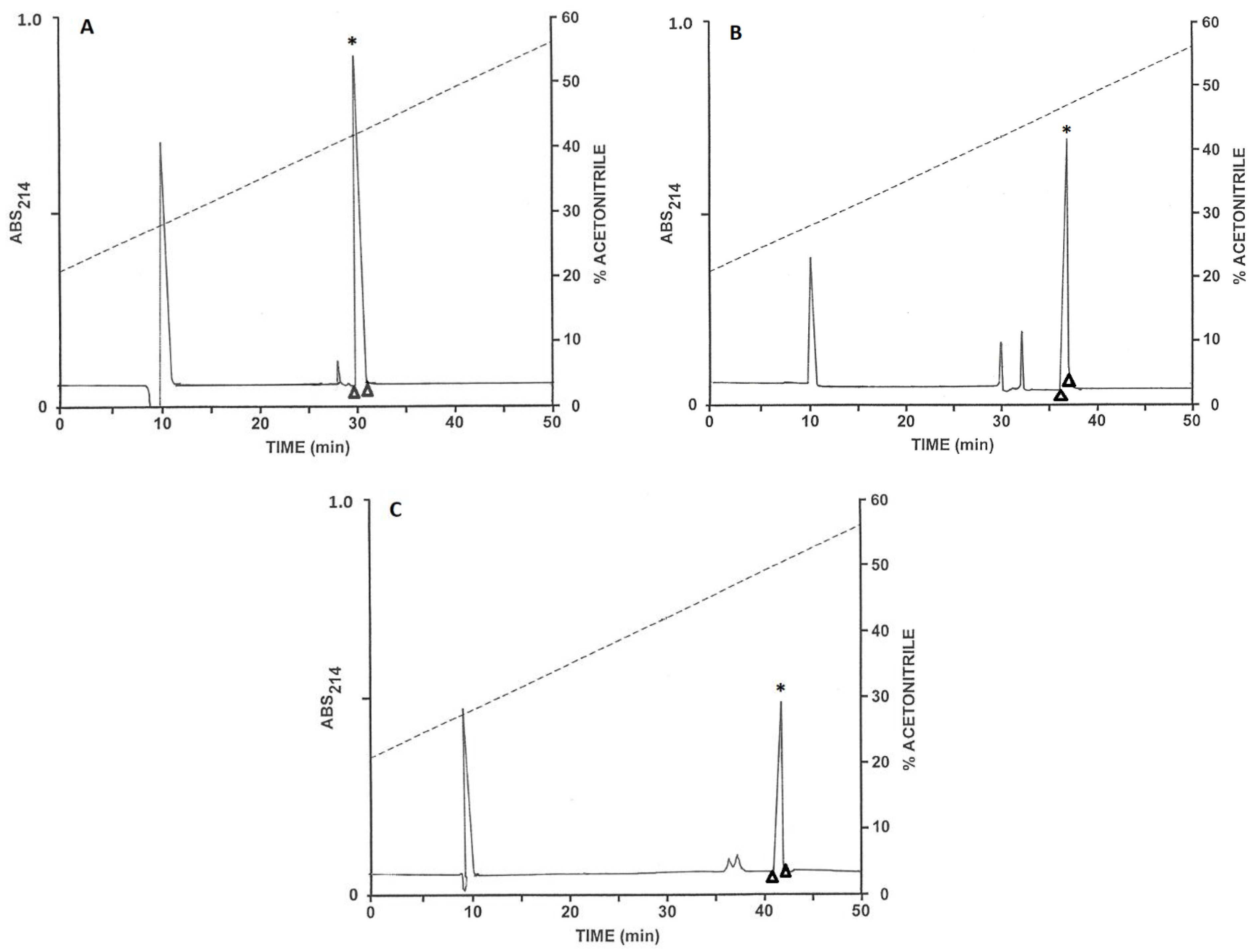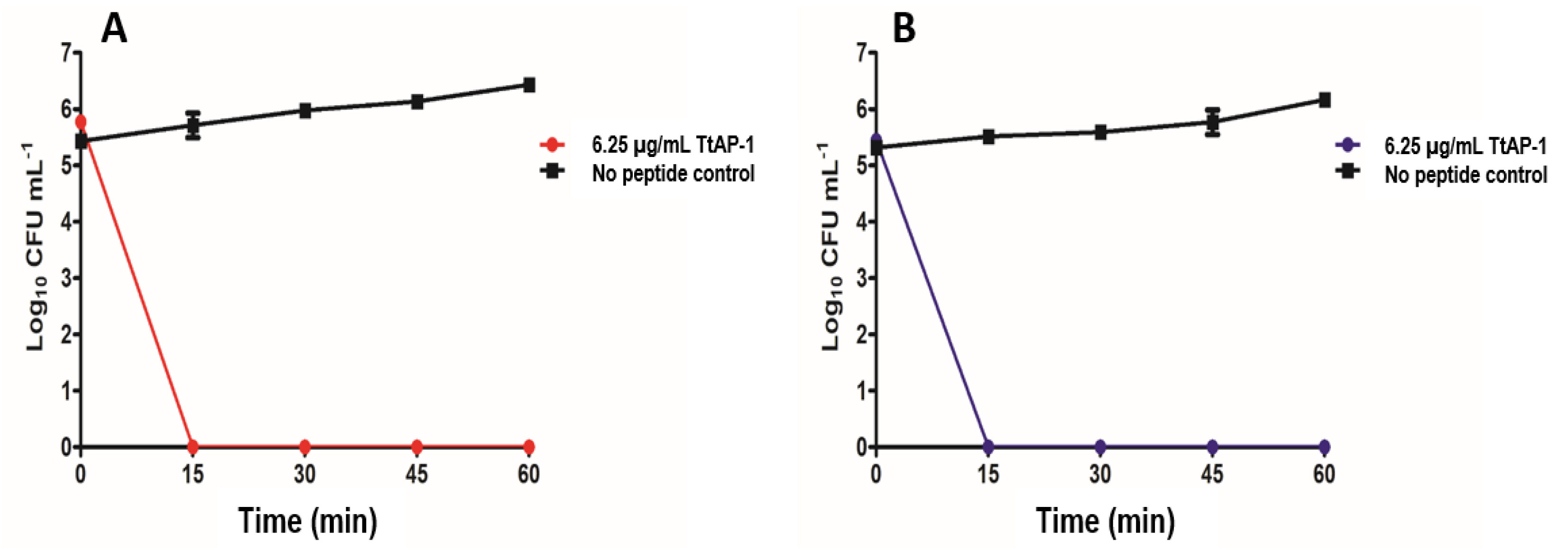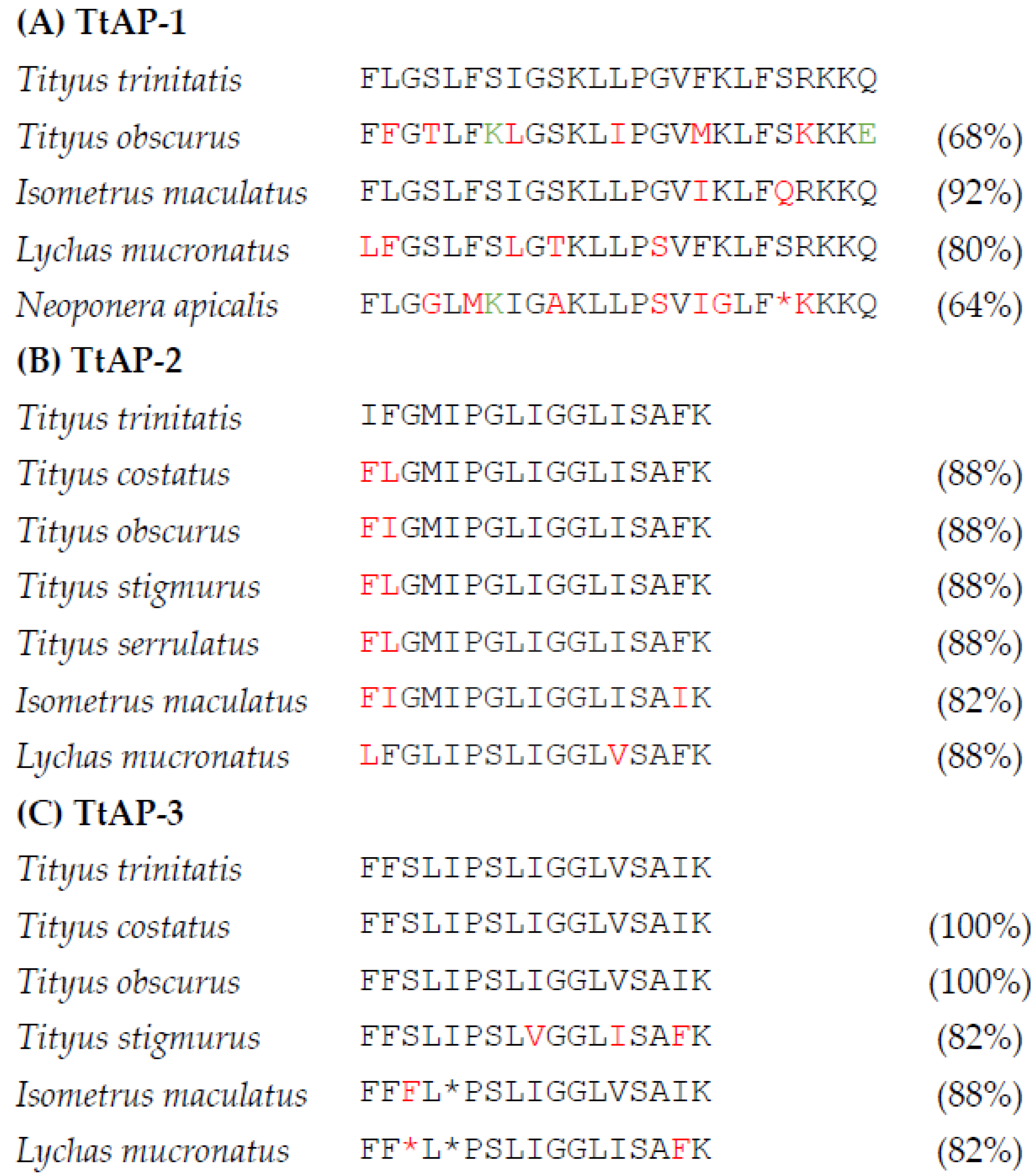Identification of an Antimicrobial Peptide from the Venom of the Trinidad Thick-Tailed Scorpion Tityus trinitatis with Potent Activity against ESKAPE Pathogens and Clostridioides difficile
Abstract
:1. Introduction
2. Results
2.1. Purification of the Peptides
2.2. Identification of the Sodium Channel and Potassium Channel Toxins
2.3. Structural Characterization of the Antimicrobial Peptides
2.4. Antimicrobial and Hemolytic Activities
3. Discussion
4. Materials and Methods
4.1. Specimen Collection
4.2. Venom Collection
4.3. Purification of the Peptides
4.4. Structural Characterization
4.5. Peptide Synthesis
4.6. Antimicrobial Assays
4.7. Hemolysis Assay
5. Conclusions
Supplementary Materials
Author Contributions
Funding
Institutional Review Board Statement
Informed Consent Statement
Data Availability Statement
Acknowledgments
Conflicts of Interest
References
- de Oliveira, A.N.; Soares, A.M.; Da Silva, S.L. Why to study peptides from venomous and poisonous animals? Int. J. Pept. Res. Ther. 2023, 29, 76. [Google Scholar] [CrossRef]
- Martins, J.G.; Santos, G.C.; Procópio, R.E.L.; Arantes, E.C.; Bordon, K.C.F. Scorpion species of medical importance in the Brazilian Amazon: A review to identify knowledge gaps. J. Venom Anim. Toxins Incl. Trop. Dis. 2021, 27, e20210012. [Google Scholar] [CrossRef] [PubMed]
- Estrada-Gómez, S.; Vargas-Muñoz, L.J.; Saldarriaga-Córdoba, M.M.; van der Meijden, A. MS/MS analysis of four scorpion venoms from Colombia: A descriptive approach. J. Venom Anim. Toxins Incl. Trop. Dis. 2021, 27, e20200173. [Google Scholar] [CrossRef] [PubMed]
- Beraldo-Neto, E.; Vigerelli, H.; Coelho, G.R.; da Silva, D.L.; Nencioni, A.L.A.; Pimenta, D.C. Unraveling and profiling Tityus bahiensis venom: Biochemical analyses of the major toxins. J. Proteom. 2023, 274, 104824. [Google Scholar] [CrossRef]
- Diego-Garcia, E.; Batista, C.V.; Garcia-Gomez, B.I.; Lucas, S.; Candido, D.M.; Gomez-Lagunas, F.; Possani, L.D. The Brazilian scorpion Tityus costatus Karsch: Genes, peptides and function. Toxicon 2005, 45, 273–283. [Google Scholar] [CrossRef]
- D’Suze, G.; Schwartz, E.F.; García-Gómez, B.I.; Sevcik, C.; Possani, L.D. Molecular cloning and nucleotide sequence analysis of genes from a cDNA library of the scorpion Tityus discrepans. Biochimie 2009, 91, 1010–10199. [Google Scholar] [CrossRef]
- de Oliveira, U.C.; Nishiyama, M.Y., Jr.; Dos Santos, M.B.V.; Santos-da-Silva, A.P.; Chalkidis, H.M.; Souza-Imberg, A.; Candido, D.M.; Yamanouye, N.; Dorce, V.A.C.; Junqueira-de-Azevedo, I.L.M. Proteomic endorsed transcriptomic profiles of venom glands from Tityus obscurus and T. serrulatus scorpions. PLoS ONE 2018, 13, e0193739. [Google Scholar] [CrossRef]
- Guo, X.; Ma, C.; Du, Q.; Wei, R.; Wang, L.; Zhou, M.; Chen, T.; Shaw, C. Two peptides, TsAP-1 and TsAP-2, from the venom of the Brazilian yellow scorpion, Tityus serrulatus: Evaluation of their antimicrobial and anticancer activities. Biochimie 2013, 95, 1784–1794. [Google Scholar] [CrossRef]
- Amorim, F.G.; Longhim, H.T.; Cologna, C.T.; Degueldre, M.; Pauw, E.; Quinton, L.; Arantes, E.C. Proteome of fraction from Tityus serrulatus venom reveals new enzymes and toxins. J. Venom Anim. Toxins Incl. Trop. Dis. 2019, 25, e148218. [Google Scholar] [CrossRef]
- Almeida, D.D.; Scortecci, K.C.; Kobashi, L.S.; Agnez-Lima, L.F.; Medeiros, S.R.; Silva-Junior, A.A.; Junqueira-de-Azevedo Ide, L.; Fernandes-Pedrosa, M.F. Profiling the resting venom gland of the scorpion Tityus stigmurus through a transcriptomic survey. BMC Genom. 2012, 13, 362. [Google Scholar] [CrossRef]
- de Melo, E.T.; Estrela, A.B.; Santos, E.C.; Machado, P.R.; Farias, K.J.; Torres, T.M.; Carvalho, E.; Lima, J.P.; Silva-Júnior, A.A.; Barbosa, E.G.; et al. Structural characterization of a novel peptide with antimicrobial activity from the venom gland of the scorpion Tityus stigmurus: Stigmurin. Peptides 2015, 68, 3–10. [Google Scholar] [CrossRef] [PubMed]
- Daniele-Silva, A.; Machado, R.J.; Monteiro, N.K.; Estrela, A.B.; Santos, E.C.; Carvalho, E.; Araújo Júnior, R.F.; Melo-Silveira, R.F.; Rocha, H.A.; Silva-Júnior, A.A.; et al. Stigmurin and TsAP-2 from Tityus stigmurus scorpion venom: Assessment of structure and therapeutic potential in experimental sepsis. Toxicon 2016, 121, 10–21. [Google Scholar] [CrossRef] [PubMed]
- de Jesus Oliveira, T.; Oliveira, U.C.; da Silva Junior, P.I. Serrulin: A glycine-rich bioactive peptide from the hemolymph of the yellow Tityus serrulatus scorpion. Toxins 2019, 11, 517. [Google Scholar] [CrossRef] [PubMed]
- Guilhelmelli, F.; Vilela, N.; Smidt, K.S.; de Oliveira, M.A.; da Cunha Morales Alvares, A.; Rigonatto, M.C.; da Silva Costa, P.H.; Tavares, A.H.; de Freitas, S.M.; Nicola, A.M.; et al. Activity of scorpion venom-derived antifungal peptides against planktonic cells of Candida spp. and Cryptococcus neoformans and Candida albicans biofilms. Front. Microbiol. 2016, 7, 1844. [Google Scholar] [CrossRef] [PubMed]
- Borges, A. New solutions to an old problem: Integrating evidence to assess the envenomation by noxious scorpions in Trinidad and Tobago. Caribb. Med. J. 2013, 75, 13–19. [Google Scholar]
- Daisley, H.; Alexander, D.; Pitt-Miller, P. Acute myocarditis following Tityus trinitatis envenoming: Morphological and pathophysiological characteristics. Toxicon 1999, 37, 159–165. [Google Scholar] [CrossRef]
- Bartholomew, C. Acute scorpion pancreatitis in Trinidad. Br. Med. J. 1970, 1, 666–668. [Google Scholar] [CrossRef]
- Bartholomew, C.; Murphy, J.J.; McGeeney, K.F.; Fitzgerald, O. Exocrine pancreatic response to the venom of the scorpion, Tityus trinitatis. Gut 1977, 18, 623–625. [Google Scholar] [CrossRef]
- Sankaran, H.; Deveney, C.W.; Bartholomew, C.; Raghupathy, E. Action of the venom of the scorpion Tityus trinitatis on pancreatic insulin secretion. Biochem. Pharmacol. 1983, 32, 1101–1104. [Google Scholar] [CrossRef]
- Sankaran, H.; Bartholomew, C.; FitzGerald, O.; McGeeney, K.F. Secretory effect of the venom of the scorpion Tityus trinitatis on rat pancreatic slices. Toxicon 1977, 15, 441–446. [Google Scholar] [CrossRef]
- O’Neill, J. Tackling Drug-Resistant Infections Globally: Final Report and Recommendations. Review on Antimicrobial Resistance. Wellcome Trust and HM Government. 2016. Available online: https://amr-review.org/sites/default/files/160525_ (accessed on 8 January 2023).
- Pendleton, J.N.; Gorman, S.P.; Gilmore, B.F. Clinical relevance of the ESKAPE pathogens. Expert Rev. Anti-Infect. Ther. 2013, 11, 297–308. [Google Scholar] [CrossRef] [PubMed]
- Mulani, M.S.; Kamble, E.E.; Kumkar, S.N.; Tawre, M.S.; Pardesi, K.R. Emerging strategies to combat ESKAPE pathogens in the era of antimicrobial resistance: A review. Front. Microbiol. 2019, 10, 539. [Google Scholar] [CrossRef] [PubMed]
- Conlon, J.M.; Attoub, S.; Musale, V.; Leprince, J.; Casewell, N.R.; Sanz, L.; Calvete, J.J. Isolation and characterization of cytotoxic and insulin-releasing components from the venom of the black-necked spitting cobra Naja nigricollis (Elapidae). Toxicon X 2020, 6, 100030. [Google Scholar] [CrossRef] [PubMed]
- Batista, C.V.; D’Suze, G.; Gomez-Lagunas, F.; Zamudio, F.Z.; Encarnacion, S.; Sevcik, C.; Possani, L.D. Proteomic analysis of Tityus discrepans scorpion venom and amino acid sequence of novel toxins. Proteomics 2006, 6, 3718–3727. [Google Scholar] [CrossRef]
- Fauchère, J.L.; Charton, M.; Kier, L.B.; Verloop, A.; Pliska, V. Amino acid side chain parameters for correlation studies in biology and pharmacology. Int. J. Pept. Protein Res. 1988, 32, 269–278. [Google Scholar] [CrossRef]
- Eisenberg, D.; Weiss, R.M.; Terwilliger, T.C. The helical hydrophobic moment: A measure of the amphiphilicity of a helix. Nature 1982, 299, 371–374. [Google Scholar]
- Gautier, R.; Douguet, D.; Antonny, B.; Drin, G. HELIQUEST: A web server to screen sequences with specific α-helical properties. Bioinformatics 2008, 24, 2101–2102. [Google Scholar] [CrossRef]
- Bernhofer, M.; Dallago, C.; Karl, T.; Satagopam, V.; Heinzinger, M.; Littmann, M.; Olenyi, T.; Qiu, J.; Schütze, K.; Yachdav, G.; et al. PredictProtein—Predicting protein structure and function for 29 years. Nucl. Acids Res. 2021, 49, W535–W540. [Google Scholar] [CrossRef]
- Miyashita, M.; Kitanaka, A.; Yakio, M.; Yamazaki, Y.; Nakagawa, Y.; Miyagawa, H. Complete de novo sequencing of antimicrobial peptides in the venom of the scorpion Isometrus maculatus. Toxicon 2017, 139, 1–12. [Google Scholar] [CrossRef]
- Ma, Y.; He, Y.; Zhao, R.; Wu, Y.; Li, W.; Cao, Z. Extreme diversity of scorpion venom peptides and proteins revealed by transcriptomic analysis: Implication for proteome evolution of scorpion venom arsenal. J. Proteom. 2012, 75, 563–1576. [Google Scholar] [CrossRef]
- Ruiming, Z.; Yibao, M.; Yawen, H.; Zhiyong, D.; Yingliang, W.; Zhijian, C.; Wenxin, L. Comparative venom gland transcriptome analysis of the scorpion Lychas mucronatus reveals intraspecific toxic gene diversity and new venomous components. BMC Genom. 2010, 11, 452. [Google Scholar] [CrossRef]
- Touchard, A.; Aili, S.R.; Fox, E.G.; Escoubas, P.; Orivel, J.; Nicholson, G.M.; Dejean, A. The biochemical toxin arsenal from ant venoms. Toxins 2016, 8, 30. [Google Scholar] [CrossRef] [PubMed]
- Del Rio, G.; Trejo Perez, M.A.; Brizuela, C.A. Antimicrobial peptides with cell-penetrating activity as prophylactic and treatment drugs. Biosci. Rep. 2022, 42, BSR20221789. [Google Scholar] [CrossRef] [PubMed]
- Daniele-Silva, A.; Rodrigues, S.C.S.; Dos Santos, E.C.G.; Queiroz Neto, M.F.; Rocha, H.A.O.; Silva-Júnior, A.A.D.; Resende, J.M.; Araújo, R.M.; Fernandes-Pedrosa, M.F. NMR three-dimensional structure of the cationic peptide stigmurin from Tityus stigmurus scorpion venom: In vitro antioxidant and in vivo antibacterial and healing activity. Peptides 2021, 137, 170478. [Google Scholar] [CrossRef]
- Conlon, J.M.; Mechkarska, M.; Arafat, K.; Attoub, S.; Sonnevend, A. Analogues of the frog skin peptide alyteserin-2a with enhanced antimicrobial activities against Gram-negative bacteria. J. Pept. Sci. 2012, 18, 270–275. [Google Scholar] [CrossRef]
- Mechkarska, M.; Prajeep, M.; Radosavljevic, G.D.; Jovanovic, I.P.; Al Baloushi, A.; Sonnevend, A.; Lukic, M.L.; Conlon, J.M. An analog of the host-defense peptide hymenochirin-1B with potent broad-spectrum activity against multidrug-resistant bacteria and immunomodulatory properties. Peptides 2013, 50, 153–159. [Google Scholar] [CrossRef]
- Amorim-Carmo, B.; Daniele-Silva, A.; Parente, A.M.S.; Furtado, A.A.; Carvalho, E.; Oliveira, J.W.F.; Santos, E.C.G.; Silva, M.S.; Silva, S.R.B.; Silva-Júnior, A.A.; et al. Potent and broad-spectrum antimicrobial activity of analogs from the scorpion peptide stigmurin. Int. J. Mol. Sci. 2019, 20, 623. [Google Scholar] [CrossRef]
- Panda, S.K.; Buroni, S.; Swain, S.S.; Bonacorsi, A.; da Fonseca Amorim, E.A.; Kulshrestha, M.; da Silva, L.C.N.; Tiwari, V. Recent advances to combat ESKAPE pathogens with special reference to essential oils. Front. Microbiol. 2022, 13, 1029098. [Google Scholar] [CrossRef]
- Proctor, C.R.; Taggart, M.G.; O’Hagan, B.M.G.; McCarron, P.A.; McCarthy, R.R.; Ternan, N.G. Furanone loaded aerogels are effective antibiofilm therapeutics in a model of chronic Pseudomonas aeruginosa wound infection. Biofilm 2023, 5, 100128. [Google Scholar] [CrossRef]
- Conlon, J.M.; Mechkarska, M.; Leprince, J. Peptidomic analysis in the discovery of therapeutically valuable peptides in amphibian skin secretions. Expert Rev. Proteom. 2019, 16, 897–908. [Google Scholar] [CrossRef]
- Oguiura, N.; Sanches, L.; Duarte, P.V.; Sulca-López, M.A.; Machini, M.T. Past, present, and future of naturally occurring antimicrobials related to snake venoms. Animals 2023, 13, 744. [Google Scholar] [CrossRef] [PubMed]
- Smits, W.K.; Lyras, D.; Lacy, D.B.; Wilcox, M.H.; Kuijper, E.J. Clostridium difficile infection. Nat. Rev. Dis. Primers 2016, 2, 16020. [Google Scholar] [CrossRef] [PubMed]
- Taggart, M.G.; Snelling, W.J.; Naughton, P.J.; La Ragione, R.M.; Dooley, J.S.G.; Ternan, N.G. Biofilm regulation in Clostridioides difficile: Novel systems linked to hypervirulence. PLoS Pathog. 2021, 17, e1009817. [Google Scholar] [CrossRef] [PubMed]
- Díaz, P.; D’Suze, G.; Salazar, V.; Sevcik, C.; Shannon, J.D.; Sherman, N.E.; Fox, J.W. Antibacterial activity of six novel peptides from Tityus discrepans scorpion venom. A fluorescent probe study of microbial membrane Na+ permeability changes. Toxicon 2009, 54, 802–817. [Google Scholar] [CrossRef]
- Raaymakers, C.; Verbrugghe, E.; Hernot, S.; Hellebuyck, T.; Betti, C.; Peleman, C.; Claeys, M.; Bert, W.; Caveliers, V.; Ballet, S.; et al. Antimicrobial peptides in frog poisons constitute a molecular toxin delivery system against predators. Nat. Common. 2017, 8, 1495. [Google Scholar] [CrossRef]
- Lüddecke, T.; Herzig, V.; von Reumont, B.M.; Vilcinskas, A. The biology and evolution of spider venoms. Biol. Rev. Camb. Philos. Soc. 2022, 97, 163–178. [Google Scholar] [CrossRef]
- Yaqoob, R.; Tahir, H.M.; Arshad, M.; Naseem, S.; Ahsan, M.M. Optimization of the conditions for maximum recovery of venom from scorpions by electrical stimulation. Pak. J. Zool. 2016, 48, 265–269. [Google Scholar]
- Schaffrath, S.; Predel, R. A simple protocol for venom peptide barcoding in scorpions. EuPA Open Proteom. 2014, 3, 239–245. [Google Scholar] [CrossRef]
- Barran, G.; Kolodziejek, J.; Coquet, L.; Leprince, J.; Jouenne, T.; Nowotny, N.; Conlon, J.M.; Mechkarska, M. Peptidomic analysis of skin secretions of the Caribbean frogs Leptodactylus insularum and Leptodactylus nesiotus (Leptodactylidae) identifies an ocellatin with broad spectrum antimicrobial activity. Antibiotics 2020, 9, 718. [Google Scholar] [CrossRef]
- Conlon, J.M.; Moffett, R.C.; Leprince, J.; Flatt, P.R. Identification of components in frog skin secretions with therapeutic potential as antidiabetic agents. Methods Mol. Biol. 2018, 1719, 319–333. [Google Scholar] [CrossRef]
- Clinical Laboratory and Standards Institute. Methods for Dilution Antimicrobial Susceptibility Tests for Bacteria That Grow Aerobically, 11th ed.; Approved Standard M07; CLSI: Wayne, PA, USA, 2019. [Google Scholar]
- Clinical Laboratory and Standards Institute. Methods for Antimicrobial Susceptibility Testing of Anaerobic Bacteria, 9th ed.; Approved Standard M11; CLSI: Wayne, PA, USA, 2018. [Google Scholar]
- Ternan, N.G.; Moore, N.D.; Smyth, D.; McDougall, G.J.; Allwood, J.W.; Verrall, S.; Gill, C.I.R.; Dooley, J.S.G.; McMullan, G. Increased sporulation underpins adaptation of Clostridium difficile strain 630 to a biologically-relevant faecal environment, with implications for pathogenicity. Sci. Rep. 2018, 8, 16691. [Google Scholar] [CrossRef] [PubMed]
- Takada, M.; Ito, T.; Kurashima, M.; Matsunaga, N.; Demizu, Y.; Misawa, T. Structure-activity relationship studies of substitutions of cationic amino acid residues on antimicrobial peptides. Antibiotics 2022, 12, 19. [Google Scholar] [CrossRef]
- You, Y.; Liu, H.; Zhu, Y.; Zheng, H. Rational design of stapled antimicrobial peptides. Amino Acids 2023, 55, 421–442. [Google Scholar] [CrossRef] [PubMed]
- Amorim-Carmo, B.; Parente, A.M.S.; Souza, E.S.; Silva-Junior, A.A.; Araújo, R.M.; Fernandes-Pedrosa, M.F. Antimicrobial peptide analogs from scorpions: Modifications and structure-activity. Front. Mol. Biosci. 2022, 9, 887763. [Google Scholar] [CrossRef] [PubMed]





| Peak No. | Molecular Mass (Da) | Classification | T. discrepans Homolog | Accession Number * |
|---|---|---|---|---|
| 1 | 6986.0 | Sodium channel toxin | Toxin TdNa5 | C9X4K3.1 |
| 2 | 7280.7 | Potassium channel toxin | Toxin TdKIK | Q0GY43.1 |
| 2 | 6957.8 | Sodium channel toxin | Toxin TdNa1 | C9X4J9.1 |
| 3 | 7682.8 | Potassium channel toxin | Toxin Tdi-β-KTx | Q0GY44.1 |
| Peak No. | Peptide | Primary Structure | [MH+]exp | [MH+]calc |
|---|---|---|---|---|
| 4 | TtAP-1 | FLGSLFSIGSKLLPGVFKLFSRKKQ a | 2796.8 | 2796.6 |
| 5 | TtAP-2 | IFGMIPGLIGGLISAFK a | 1733.1 | 1733.0 |
| 6 | TtAP-3 | FFSLIPSLIGGLVSAIK a | 1761.1 | 1761.1 |
| Peptide | Charge at pH 7.0 | Hydrophobicity | Hydrophobic Moment | Predicted Helical Domain |
|---|---|---|---|---|
| TtAP-1 | +6 | 0.562 | 0.427 | 2–24 |
| TtAP-2 | +2 | 0.906 | 0.597 | 4–15 |
| TtAP-3 | +2 | 0.895 | 0.592 | 4–15 |
| Microorganism | Peptide TtAP-1 | Peptide TtAP-2 | Peptide TtAP-3 | GEN | VAN |
|---|---|---|---|---|---|
| P. aeruginosa DSM 50071 | 12.5 | >400 | >400 | 3.91 | nd |
| E. coli DSM 787 | 6.25 | 100 | 200 | 0.98 | nd |
| K. pneumoniae ATCC BAA 1705 | 6.25 | >100 | >400 | 0.98 | nd |
| A. baumannii DSM 30008 | 6.25 | 50 | 100 | 0.98 | nd |
| S. aureus ATCC 43300 | 6.25 | 25 | 25 | 31.3 | nd |
| S. epidermidis DSM 28319 | 6.25 | 25 | 100 | 0.49 | nd |
| E. faecalis MF 06036 | 6.25 | 50 | 100 | 3.91 | nd |
| E. faecium NCTC 12201 | 6.25 | 25 | 50 | 1.95 | nd |
| C. difficile DSM 27147 | 3.13 | 25 | 50 | nd | 1.0 |
| C. difficile ATCC BAA 1382 | 3.13 | 25 | 50 | nd | 1.0 |
Disclaimer/Publisher’s Note: The statements, opinions and data contained in all publications are solely those of the individual author(s) and contributor(s) and not of MDPI and/or the editor(s). MDPI and/or the editor(s) disclaim responsibility for any injury to people or property resulting from any ideas, methods, instructions or products referred to in the content. |
© 2023 by the authors. Licensee MDPI, Basel, Switzerland. This article is an open access article distributed under the terms and conditions of the Creative Commons Attribution (CC BY) license (https://creativecommons.org/licenses/by/4.0/).
Share and Cite
Mechkarska, M.; Cunning, T.S.; Taggart, M.G.; Ternan, N.G.; Leprince, J.; Coquet, L.; Jouenne, T.; Tena-Garcés, J.; Calvete, J.J.; Conlon, J.M. Identification of an Antimicrobial Peptide from the Venom of the Trinidad Thick-Tailed Scorpion Tityus trinitatis with Potent Activity against ESKAPE Pathogens and Clostridioides difficile. Antibiotics 2023, 12, 1404. https://doi.org/10.3390/antibiotics12091404
Mechkarska M, Cunning TS, Taggart MG, Ternan NG, Leprince J, Coquet L, Jouenne T, Tena-Garcés J, Calvete JJ, Conlon JM. Identification of an Antimicrobial Peptide from the Venom of the Trinidad Thick-Tailed Scorpion Tityus trinitatis with Potent Activity against ESKAPE Pathogens and Clostridioides difficile. Antibiotics. 2023; 12(9):1404. https://doi.org/10.3390/antibiotics12091404
Chicago/Turabian StyleMechkarska, Milena, Taylor S. Cunning, Megan G. Taggart, Nigel G. Ternan, Jérôme Leprince, Laurent Coquet, Thierry Jouenne, Jordi Tena-Garcés, Juan J. Calvete, and J. Michael Conlon. 2023. "Identification of an Antimicrobial Peptide from the Venom of the Trinidad Thick-Tailed Scorpion Tityus trinitatis with Potent Activity against ESKAPE Pathogens and Clostridioides difficile" Antibiotics 12, no. 9: 1404. https://doi.org/10.3390/antibiotics12091404
APA StyleMechkarska, M., Cunning, T. S., Taggart, M. G., Ternan, N. G., Leprince, J., Coquet, L., Jouenne, T., Tena-Garcés, J., Calvete, J. J., & Conlon, J. M. (2023). Identification of an Antimicrobial Peptide from the Venom of the Trinidad Thick-Tailed Scorpion Tityus trinitatis with Potent Activity against ESKAPE Pathogens and Clostridioides difficile. Antibiotics, 12(9), 1404. https://doi.org/10.3390/antibiotics12091404








